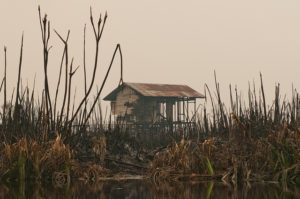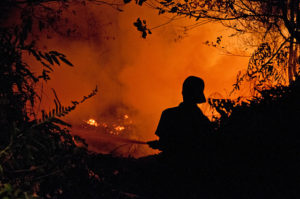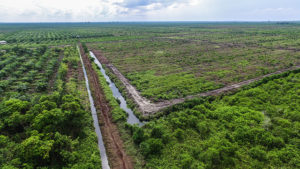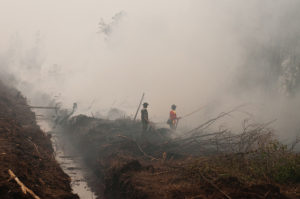
Fire and haze, a recurring problem in Indonesia, must be addressed not only within the country but also on a regional level, according to Centre for International Forestry Research (CIFOR) scientist Herry Purnomo.
The issue, which often sparks a debate of environmental conservation versus livelihoods, needs to be resolved by taking into account the economic, environmental and social aspects of sustainability.
Purnomo and other scientists working in the field hope relevant research, leading to outputs that create an academic narrative to inform policymakers, will create the possibility of legal changes. This, in turn, could help to alleviate the annual blazes.
Recognizing the problems at hand in terms of communication and synergy, CIFOR and partners are coordinating a National Policy Dialogue on Laws and Best Practices for Reducing Fire and Haze, in collaboration with the University of Riau, set to be held in Pekanbaru, Riau, on Aug. 30. The event will come close to home for many participants, as the province has seen more than its fair share of fire and haze events.
Read more: Peatland fire policy: From past to present
The dialogue aims to maximize opportunities provided by the Indonesian legal system at national and subnational levels to reduce fires and share lessons learned from best practices, and is expected to develop ways to strengthen laws to reduce fires and haze, communicate strategies from communities and companies, and support common action among ASEAN member countries.
Purnomo sat down with FTA to discuss the value of the national dialogue and what he hoped would be achieved between stakeholders.
How does research inform the debate about fire and haze in Indonesia?

This event is part of a UK Department for International Development (DFID) project called the Political Economy Study of Fire and Haze – carried out by CIFOR and partners, and also supported by FTA – mostly located in Riau province. For two years we have been working together with the parliament in Riau as well as district level government.
The research has led to outputs that have created an academic narrative, which has led to the possibility of changes in the law. Last year we provided research inputs for this year’s legislation program through a legal drafting workshop and consultative meetings with various stakeholders including governments, parliament members, private sectors, NGOs/CSOs and academics. We then developed the national dialogue to communicate and also to scale up and scale out the project, not only in Riau.
Peat fires are seen as a means to quickly and cheaply clear land for plantations. But what about the economic and social consequences that result from the haze, which also cost money?
CIFOR is working to find the right balance between conservation and economic development. If we stopped burning altogether, it would be difficult for local people to have a livelihood. Local authorities also need to help find the appropriate balance. To me there’s no magic formula unless you can understand the situation in a particular area and move forward.
We can incentivize other ways of clearing the land and ‘disincentivize’ the burning. In the local law we have put that local governments need to invest, working together with the national agency for technology application, to find the cheapest technology for preparing land without burning.

There also needs to be a willingness from the community. It’s not cheap at all. You need to learn; you need new technology. Communities need champions.
Why is CIFOR holding the event in Riau?
When fire starts in Riau, it causes haze problems not only in Indonesia but also in Malaysia. Meanwhile, fires in South Sumatra can cause problems in Singapore. Fires typically start in Riau, then Sumatra, Kalimantan and Papua. Whatever happens becomes not only a domestic problem but a regional problem.
- Fire economy and actor network of forest and land fires in Indonesia
- The political economy of fire and haze in Indonesia
Why are laws to protect against expanding plantations on peatland not always well enforced in Indonesia?
Because of patronage. Who burns the land? On the ground you can see farmers. But who owns the land? Actually not those farmers. The land is owned or managed by what we call oknum or cukong, free riders and rent seekers in economic terms. Oknum want to obtain a lot of benefits without appropriate investment. Oknum can be investors, scientists, members of parliament, government officials, police, members of the army, corporate staff… They are linked with lawmakers, and linked with bad police. So it’s a bit complicated on the ground.
Corruption is often involved. But it’s getting better in Indonesia. We have been giving inputs to the law draft at the local level, to provide incentives, and provide more equipment for the police to better carry out law enforcement.
Currently it’s hard for the police to find evidence about who burns land, because to find it, they have to go to remote areas. I went there; I had to rent a 4WD car and it took four days just to reach the area. For example, if there is land burning in a national park, it’s difficult to get there.
You need to spend money if you want to understand the actors. But there is not much money available at the local level to prevent fire and haze. Can we give more support to the local police, to make it possible for them to find evidence? In court we need proof. Proof is important for laying blame.
What needs to be done to ensure that laws and regulations are upheld by the central governments, local administrations, smallholders, the private sector and other actors?
That’s something we included in our inputs to the local law drafts – that local governments have to provide support and money to the police, and also to improve the capacity of the judges. There’s a big difference between environmental charges and criminal charges.
We are working step by step. From the evidence on the ground, when we tried to develop canal blocking or improve farmer organizations, the districts said they didn’t have a budget for it. They said there was no legal umbrella, and asked why they had to put aside money for it.
So, we thought, why don’t we help make a legal basis for them to be able to provide money for this issue? That is the purpose behind the national dialogue.
- Indonesian peatland fires: Perceptions of solutions
- Oil palm-community conflict mapping in Indonesia: A case for better community liaison in planning for development initiatives

What are some of the best practices that should be shared and implemented by these actors?
We have several examples of community-based restoration. In the private sector, Asia Pulp and Paper (APP) has a program and APRIL has the Fire-Free Villages program. So I invited them to share lessons and challenges.
Restoration in nine villages, for example, costs a lot through this type of program. A hundred villages would cost a lot more. The companies would like the government to help by taking responsibility for giving incentives for preparing land without burning. It’s good but we need to out-scale.
APP, for example, has 500 villages to deal with inside and around its concession. It’s impossible without involving public money and public investment.
What needs to be done regionally – across ASEAN – to address this issue?
A lot of high-level talks happen but there needs to be more done on the ground. I met with the second secretary of Singapore to discuss what Singapore could do to collaborate and invited them to the national dialogue. Government and private sector representatives from Malaysia and Singapore are expected to attend the national dialogue, as well as academics, and representatives from the ASEAN Secretariat. The Singapore, Thai and Malaysian embassies have been invited.
There is a vision, led by Thailand, for a “haze-free ASEAN by 2020.” It’s very ambitious. We also have a transboundary agreement on haze that has become law. But to me it seems like there is not much action on the ground. We want them to be more involved in the on-the-ground activities. If you have something on the ground, people will respect you. Why not have a district model – one or two hectares showing how fire prevention and livelihood improvement can work together?
It’s part of a huge debate between peat conservation and oil palm. Not only between government and private sectors, but actually among government representatives themselves – for example, with the minister of environment on the one hand and the minister of industry on the other hand. It’s about how to find synergy.
- Can communities and lawmakers stop Indonesian peat fires?
- Indonesia can stamp out forest and land fires – with serious action
By Hannah Maddison-Harris, FTA Communications and Editorial Coordinator.
This work forms part of the CGIAR Research Program on Forests, Trees and Agroforestry (FTA), which is supported by CGIAR Fund Donors.











